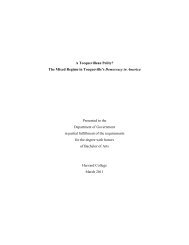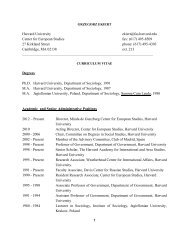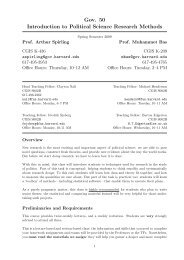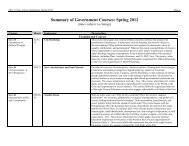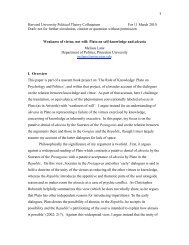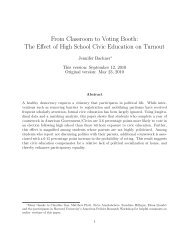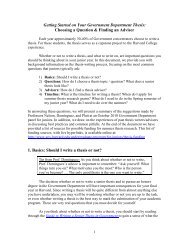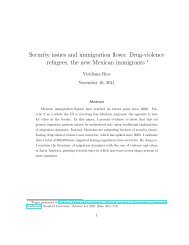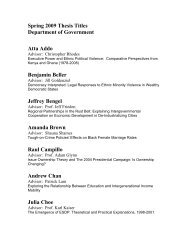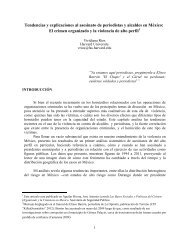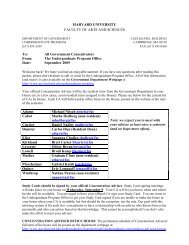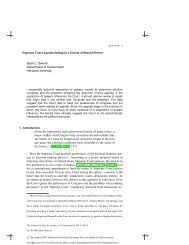Why did Mexico become so violent? - Department of Government ...
Why did Mexico become so violent? - Department of Government ...
Why did Mexico become so violent? - Department of Government ...
You also want an ePaper? Increase the reach of your titles
YUMPU automatically turns print PDFs into web optimized ePapers that Google loves.
Author's per<strong>so</strong>nal copy<br />
Trends Organ Crim (2013) 16:138–155 139<br />
A wave <strong>of</strong> drug-related violence has hit <strong>Mexico</strong>. From December 2006 to June<br />
2010, 41,648 killings have been <strong>of</strong>ficially linked to drug trafficking organizations, a<br />
dramatic increase from previous years (2001–2006) when only 8,901 killings were<br />
linked to organized crime (Rios and Shirk 2011). In 2010, drug-related homicides<br />
reached the record figure <strong>of</strong> 15,273 victims, making organized crime <strong>of</strong>ficially<br />
responsible for 45 % <strong>of</strong> all intended homicides in the country (Rios and Shirk<br />
2011). As a result, Mexican cities like Ciudad Juárez – a crucial trans-shipment point<br />
for the introduction <strong>of</strong> cocaine into the US – exhibited homicide rates <strong>of</strong> 216 victims<br />
per 100,000 inhabitants in 2010, a casualty rate that is comparable to that <strong>of</strong> war<br />
zones.<br />
The escalation <strong>of</strong> drug-related violence within <strong>Mexico</strong> is a puzzle. The country had<br />
long been a supplier <strong>of</strong> illegal drugs without this business causing any significant<br />
violence. Since at least 1994, <strong>Mexico</strong> took the place <strong>of</strong> Colombia as the most<br />
important point <strong>of</strong> entry <strong>of</strong> illegal drugs into the US, supplying about 70 % <strong>of</strong> the<br />
cocaine, 80 % <strong>of</strong> the marijuana, and 30 % <strong>of</strong> the heroine consumed in the country<br />
(Andreas 1998). <strong>Mexico</strong> was home to an illegal business generating billions <strong>of</strong><br />
dollars – and employing at least 5,000 armed actors – which until recently operated<br />
under a functional, non-<strong>violent</strong> equilibrium. 2 The way in which drug-related homicides<br />
spun out <strong>of</strong> control after 2006 cries for an explanation. The goal <strong>of</strong> this paper is<br />
to provide it.<br />
The argument has two parts. First, it will be shown that drug-related violence is<br />
caused by two mechanisms: (1) traffickers battling for turf to control competitive<br />
markets (“competition”), and (2) government efforts to reduce drug trafficking<br />
operations (“enforcement”). Second, it will be illustrated that these two mechanisms<br />
have interacted to lock <strong>Mexico</strong> into a “self-reinforcing <strong>violent</strong> equilibrium.” In<br />
particular, pro<strong>of</strong> will be presented on how battles for turf increase the incentives <strong>of</strong><br />
the government to enforce the law, which further increase battles for turf. Violence is<br />
self-reinforced because after the prosecution <strong>of</strong> criminal leaders, incentives are<br />
generated for the remnants <strong>of</strong> the criminal organization to keep battling, this time<br />
to select a new leader. The argument is supported by a unique dataset <strong>of</strong> communications<br />
between drug trafficking organizations as well as by quantitative data on<br />
drug-related homicides.<br />
This article flows in four sections. First, trends in <strong>Mexico</strong>’s drug-related homicides<br />
are described, emphasizing the temporal, geographic, and qualitative characteristics<br />
<strong>of</strong> these trends. This section al<strong>so</strong> provides an overview <strong>of</strong> the ways that the current<br />
literature has explained these trends, and on how the approach adopted here departs<br />
from the conventional accounts. Second, the ingredients <strong>of</strong> drug-related violence are<br />
explained in terms <strong>of</strong> competition and enforcement and the ways in which these<br />
mechanisms interact to generate a self-reinforcing <strong>violent</strong> equilibrium. In section<br />
three, a simple quantitative test to assess the contribution <strong>of</strong> each ingredient <strong>of</strong> drugrelated<br />
violence is presented, along with case studies to show the mechanics <strong>of</strong> the<br />
self-reinforcing <strong>violent</strong> equilibrium. Turf wars emerge when monopolistic control <strong>of</strong><br />
territories by drug-trafficking organizations is broken, when territories <strong>become</strong> competitive<br />
and traffickers fight for them. Through an analysis <strong>of</strong> the areas <strong>of</strong> operation <strong>of</strong><br />
2 Author interview with anonymous <strong>of</strong>ficial <strong>of</strong> <strong>Mexico</strong>’s main intelligence agency, the Center for Research<br />
and National Security (Centro de Investigación y Seguridad Nacional, CISEN).



